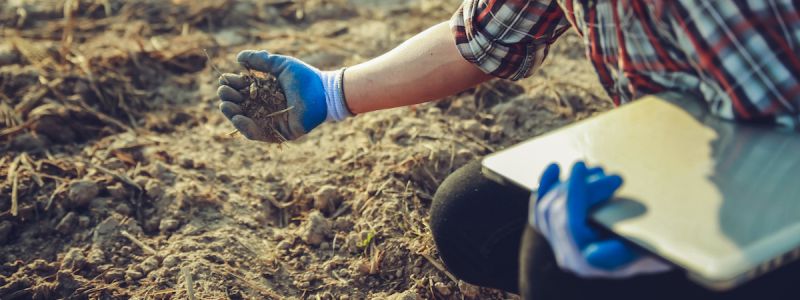Facts and Figures
Soil facts and figures:
- 95% of global food supplies are directly or indirectly produced on soil. NFU (2018)
- One teaspoon of soil contains more living organisms than there are people in the world. FAO (2020)
- UK soils store over 10 billion tonnes of carbon in the form of organic matter. Roughly equal to 80 years of annual UK greenhouse gas emissions. Environment Agency (2019)
- It is estimated that in the UK, soil is being destroyed 10 times faster than it is being created. WWF (2018)
- Around 17% of arable soils in England and Wales show signs of erosion and 40% (2 million ha) are thought to be at risk. Environment Agency (2019)
-
Almost 4 million ha of agricultural land in England and Wales are at risk of compaction, affecting soil fertility, water resources and increasing flood risk. Environment Agency (2019)
- In the UK, intensive agriculture has caused arable soils to lose 40-60% of their organic carbon. Environment Agency (2019)
- The annual costs of soil degradation in England and Wales are between £0.9 and £1.4 billion, with a central estimate of £1.2 bn. These costs are mainly linked to loss of organic content of soils (47% of total), compaction (39%) and erosion (12%). Graves et al (2014)
- The contribution of damaged soils to flooding events is estimated to be £233m/year. Parliamentary Office of Science & Technology (2015)
- Around 300,000 hectares of UK soil are thought to be contaminated with toxic elements – such as cadmium, arsenic and lead. Environmental Audit Committee (2016)
- English farmers are losing valuable resources through diffuse pollution. 235,000 tonnes of nitrogen and 8,391 tonnes of phosphorus are lost every year that would otherwise help sustain farming. Defra (2015)

Soil monitoring (England) facts and figures:
- The Environment Agency has acknowledged that “there is insufficient data on the health of our soils and investment is needed in soil monitoring”. Environment Agency (2019)
- Unlike other assets assessed by the Natural Capital Committee (NCC), there are no government national statistics on the state of soils in England. NCC (2020)
- The most recent national data sets were collected as part of the Countryside Survey in 2007, 1998 and 1978, and the National Soil Inventory, which took samples in the 1990s and 1980s. Environment Agency (2019)
- The Sustainable Soil Alliance’s (SSA) freedom of information request revealed that England’s spending on soil monitoring was only 0.4% of that spent on air and water. SSA (2020)

Regulations (England) facts and figures:
- Enforcement action by the Environment Agency on breaches remains negligible with 3 warning letters issued in 2019/20. No notices have been served relating to any breach from 2018-2020. Unchecked UK (2019)
- From 2010/11 to 2016/17 the “total Environment Agency prosecutions of businesses fell by 80%”. Unchecked UK (2019)
- It used to be the case that on average each farm would be inspected once every 100 years (pers com), but recent cuts to the Environment Agency's budgets have increased this to 263 years. Salmon & Trout Conservation (S&TC) in ENDS (2020)
- Regulatory budgets in the UK have fallen by 41% in real terms over the last decade. Unchecked UK (2019)
- From 2010/11 to 2016/17, the Environment Agency’s environmental protection budget fell by 62%. Environment Agency staff fell by 22%. Unchecked UK (2019)

Peat facts and figures:
- Peatlands cover only 3% of the earth’s surface, but contain c.1/3 total soil carbon - more than twice the amount of carbon stored in the world’s forests. UNEP (2019)
- Peat makes up around 12% of UK land, yet stores over 3 billion tonnes of carbon, equivalent to all carbon stored in the forests in the UK, Germany and France together. ONS (2019)
- The UK’s peatlands are an internationally-significant nature habitat, home to large numbers of wildlife species including - some of which are endangered. ONS (2019)
- Deep peat takes thousands of years to form, with a growth rate of about 1mm per year. Charman (2002)
- Peat is a natural filter for purifying water, reducing the extent to which water companies need to treat it before supplying to communities. Ritson et al (2016)
Poor or inappropriate land management is the most significant threat to peat in the UK. Degradation affects its ability to perform natural functions beneficial to people, biodiversity and climate.
- The UK has lost 94% of its lowland peatlands. JNCC (2019)
- Of all UK peatlands, only around 20% remain in a near-natural state. 80% are damaged. IUCN (2018)
- In England, only 4% of upland deep peatlands are in good condition. The Climate Change Committee (2013)
- The state of Scotland’s blanket bog was described as ‘unfavourable declining’ - in a poor state. Scottish Natural Heritage (2013)
- Only 30% of the Welsh peat soil area is considered to be in ‘good condition’. The Glastir Monitoring and Evaluation Programme (2015)
- Around 80% of Northern Ireland’s peatlands have been degraded and require restoring. RSPB NI (2020)
- Lowland peatlands are amongst the largest sources of GHG emissions from the UK land-use sector, due to drainage and agriculture. Evans et al (2016)
